HTRF® package insert Anti-GST-XL665 - Cisbio Bioassays
HTRF® package insert Anti-GST-XL665 - Cisbio Bioassays
HTRF® package insert Anti-GST-XL665 - Cisbio Bioassays
Create successful ePaper yourself
Turn your PDF publications into a flip-book with our unique Google optimized e-Paper software.
R&D, Administration and Europe Office<br />
<strong>Cisbio</strong> <strong>Bioassays</strong><br />
Phone: +33 (0)4 66 79 67 05<br />
Fax: +33 (0)4 66 79 19 20<br />
E-mail: bioassays@cisbio.com<br />
Japan Office<br />
Sceti Medical Labo K.K.<br />
Phone: +81 (0)3 5510 2932<br />
Fax: +81 (0)3 5510 0130<br />
E-mail: reagent@scetimedilabo.co.jp<br />
USA Office<br />
<strong>Cisbio</strong> US, Inc.<br />
Phone : 888 963 4567<br />
Fax : 781 687 1500<br />
E-mail : htrfinfo@cisbio.us<br />
www.htrf.com<br />
HTRF ® <strong>package</strong> <strong>insert</strong><br />
Document reference : 61<strong>GST</strong>XLA/B rev07 (July 2009)<br />
1. Background<br />
For in vitro research use only<br />
Storage temperature : 2-8°C<br />
The development of fusion protein technology has boosted the use of toolbox reagents for the purification and the detection of recombinant proteins. This technique consists in<br />
the addition of a specific sequence (i.e. tag) to the protein to be expressed. These tags can be <strong>insert</strong>ed at different places in the sequence and are often added to N or C-terminal<br />
ends to guarantee the production of a biologically active recombinant protein. The protein can then be detected through the tag using toolbox reagents (e.g. antibodies raised<br />
against this tag or proteins having an affinity for it).<br />
Glutathione S-transferase – an enzyme involved in animal cell detoxication – is one of the most widely used tags in molecular biology. Both eukaryotic and bacterial expression<br />
vectors for the production of <strong>GST</strong> tagged proteins are commercially available. Expressed fusion proteins can be purified by immobilized glutathione affinity chromatography, the<br />
<strong>GST</strong> moiety being removable if necessary via a specific enzymatic cleavage site introduced in the construct (e.g. thrombin).<br />
When tagged with <strong>GST</strong>, fusion proteins can be easily detected by anti-<strong>GST</strong> specific antibodies. GSS11 is a mouse monoclonal IgG2a which was raised against <strong>GST</strong> from Schistosoma<br />
japonicum. This monoclonal was shown to react with <strong>GST</strong>-tagged fusion protein from a large number of expressing vectors. It is suitable for use in a wide variety of protein:<br />
protein binding and receptor:ligand binding applications.<br />
The accessibility of the <strong>GST</strong> epitope on the fusion proteins by anti-<strong>GST</strong> toolbox reagents can be assessed using the <strong>HTRF®</strong> <strong>GST</strong> check kit (62<strong>GST</strong>PEB).<br />
This toolbox reagent has been developed for High Throughput Screening using the HTRF technology. HTRF is an homogeneous time-resolved fluorescent technique, based on the<br />
energy transfer between a long-life fluorescent cryptate donor (Europium or Lumi4-Terbium) and HTRF acceptors such as <strong>XL665</strong>, d2, or other suitable acceptor fluorophores (i.e.<br />
GFP, fluorescein...). The transferred energy is then emitted as detectable fluorescent signal. In HTRF assays, the donor and the acceptor are conjugated to biomolecules (anti-tag<br />
antibodies, streptavidins, peptides,...) for studying molecular interactions.<br />
References:<br />
Trinquet E. Studying molecular interactions with the new Lumi4®-Tb Cryptate HTRF toolbox. SBS 15th annual conference 2009, Lille (France).<br />
Wilson A., Nimar L., Houghter A., Cherenson R., Conolly L., Lerner A. The structure of an <strong>Anti</strong>genic Determinant in a Protein. Cell 1994;37:767-778.<br />
Cartwright G.A., Rothel J.S. and Lightowlers M.W. Conventional immunoassays underestimate anti-<strong>GST</strong> antibody titre. J Immunol Methods. 1995;179:31-5.<br />
Mathis G. Probing molecular interactions with homogeneous techniques based on rare earth cryptates and fluorescence energy transfer. Clin Chem. 1995;41:1391-7<br />
Smith D. and Johnson K.S. Single-step purification of polypeptides expressed in Escherichia coli as fusions with glutathione S-transferase. Gene. 1986;67:31-40.<br />
2. Reagent description<br />
GSS11 monoclonal antibody is produced and labeled with <strong>XL665</strong> at <strong>Cisbio</strong> <strong>Bioassays</strong>. Specific activity of the conjugate ranges from 1.5 to 2.0 <strong>XL665</strong>/antibody.<br />
This conjugate is lyophilized in 100 mM Phosphate pH 7.0, 0.1% protease free bovine serum albumin (BSA) and stabilizers.<br />
In 384-well low volume plate format using a final volume of 20 µL, each vial from the two available sizes enables respectively the assessment of 5,000 and 20,000 tests on the basis<br />
of 20 ng of antibody per well (i.e. 0.13 pmol/well). Actual amount per well will be dependent on optimized assay conditions. As a general rule, anti-<strong>GST</strong>-<strong>XL665</strong> working concentration<br />
should never be lower than that of the tagged compound to be detected.<br />
3. Reagent handling<br />
3.1. Preparation of the working solution<br />
<strong>Anti</strong>-<strong>GST</strong>-<strong>XL665</strong><br />
<strong>XL665</strong>-conjugated mouse monoclonal antibody<br />
anti-glutathione S-transferase<br />
Packaging details :<br />
384-well low volume plate (20 µL)<br />
61<strong>GST</strong>XLA 5,000 tests<br />
61<strong>GST</strong>XLB 20,000 tests<br />
· Allow the lyophilized reagent to warm up at room temperature for at least 30 minutes.<br />
· For the 5,000 test vial (61<strong>GST</strong>XLA) : reconstitute the product with 250 µL of distilled water in order to obtain a 0.4 mg/mL solution (antibody concentration).<br />
· For the 20,000 test vial (61<strong>GST</strong>XLB) : reconstitute the product with 1 mL of distilled water in order to obtain a 0.4 mg/mL solution (antibody concentration).<br />
· Vortex the solution gently.<br />
· After reconstitution, the stock solution can be divided into aliquots and frozen at -80°C for additional use (according to storage conditions, see §5).<br />
· Dilute with buffer the stock solution to the working concentration. Mix gently.
3.2. Recommended buffer<br />
Most common buffers can be used for the preparation of the working solution, providing that the pH is maintained between 5.5 and 8.5. They can be complemented with<br />
BSA (0.1%) to prevent reagent coating, and detergents such as Tween 20, Triton X100, CHAPS (up to 0.5%)… may also be added. Avoid SDS, due to its denaturing effect. It is<br />
recommended to check the background signal by counting the buffer blank.<br />
KF can play an essential role in the lanthanide cryptate protection by preventing the action of possible quenchers contained in the assay. KF is mandatory for HTRF assays using<br />
Europium cryptate. KF is generally used at a final concentration of 100 to 400mM, and is added to the conjugate working solutions or dispensed in a separate step, just before the<br />
readout. Assay using Lumi4-Tb cryptate donor, does not require KF.<br />
4. Assay flexibility and miniaturization<br />
When used as suggested, one vial from the two available sizes will provide sufficient reagent for 5,000 and 20,000 tests respectively using a 384-well low volume plate in 20 µL<br />
final assay volume (<strong>HTRF®</strong> <strong>package</strong>d basis).<br />
To move to other plate formats (96 half-well or 1536-well) and final volumes (100 µL to less than 10 µL), the volume of each assay component is simply proportionally adjusted in<br />
order to maintain the reagent concentrations as for the 20 µL final assay volume. For instance, in the case of the 1536-well format in 10 µL final volume, 2 times less material per<br />
well is used, thereby allowing 10,000 and 40,000 tests respectively to be run. The performances of the <strong>HTRF®</strong> assay remain the same whatever the level of miniaturization.<br />
Assay components Volume proportion<br />
1536-well<br />
(10 µL)<br />
Assay format<br />
384-well low volume<br />
(20 µL)<br />
Other assay components 2 volume 5 µL 10 µL 50 µL<br />
Copyright © 2009 CIS bio international, France<br />
<strong>HTRF®</strong>, TRACE®, and the HTRF logo are trademarks belonging to CIS bio international.<br />
<strong>HTRF®</strong> products are manufactured under one or more of the following patents and foreign equivalent : EP 0 180 492 / US 4,927,923 / US 5,220,012 / US 5,432,101 – EP 0 321 353 / US 5,457,185 /<br />
US 5,534,622 / US 5,346,996 / US 5,162,508 – EP 0 539 477 / US 5,512,493 – EP 0 539 435 / US 5,627,074 – EP 0 569 496 / US 5,527,684.<br />
CIS bio international hereby grants to those buying <strong>HTRF®</strong> products from CIS bio international or its affiliates / distributors, a worldwide, non-exclusive, royalty-free, limited license to use <strong>HTRF®</strong> technology with said products<br />
for in-house life science research only. Signal amplification and correction using <strong>HTRF®</strong> technology are covered by the following U.S. patents or patent applications and foreign equivalents :<br />
US 5,512,493 – US 5,527,684 – US 6,352,672.<br />
Lumi4 is a registered trademark of Lumiphore, Inc. Lumi4-based products may be covered under one or more of U.S. patents: 6,515,113, 6,864,103, 7,442,558, 6,406,297, 7,018,850, and 7,404,912 or international equivalents.<br />
96 half-well<br />
(100 µL)<br />
Acceptor conjugate 1 volume 2.5 µL 5 µL 25 µL<br />
Cryptate conjugate 1 volume 2.5 µL 5 µL 25 µL<br />
Small size 10,000 tests 5,000 tests 1,000 tests<br />
Bulk size 40,000 tests 20,000 tests 4,000 tests<br />
Plate references : 96 half-well plate (Costar # 3694 or equivalent), 384-well low volume plate (Greiner # 784076), 1536-well (Greiner # 782086).<br />
5. Storage conditions and stability<br />
Lyophilized anti-<strong>GST</strong>-<strong>XL665</strong> conjugate should be stored at 2-8°C until reconstituted. Under proper storing conditions, this reagent is stable until the expiry date indicated on the<br />
product description datasheet.<br />
Once reconstituted, stock solutions are stable two days at 2-8°C. They can be refrozen (at -80°C) and thawed once only. Do not repeat freezing and thawing.<br />
Caution ! It is possible to combine donor and acceptor conjugates immediately before use. Do not store donor and acceptor conjugates mixed together for extended<br />
periods of time.


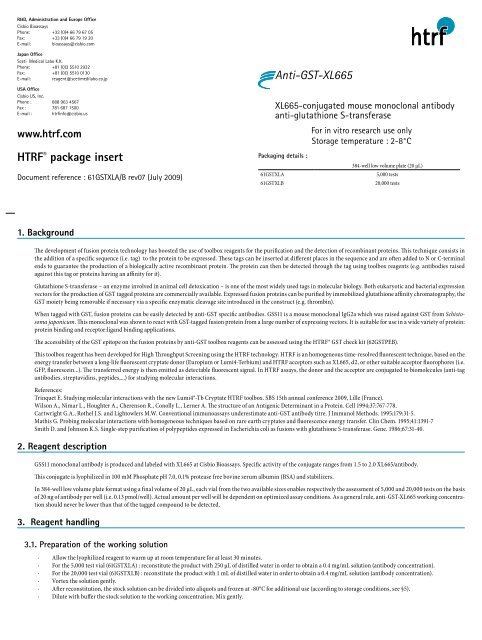
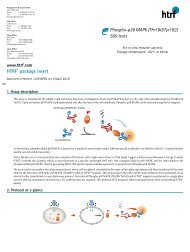

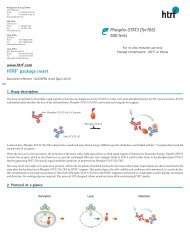
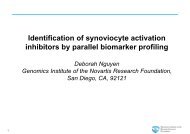
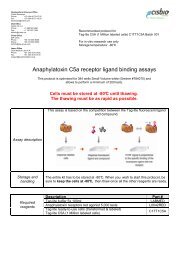
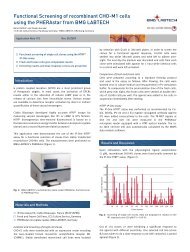
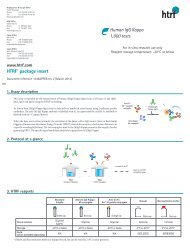
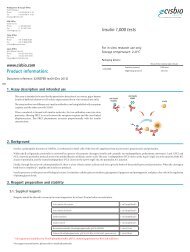

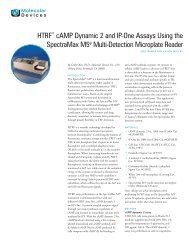
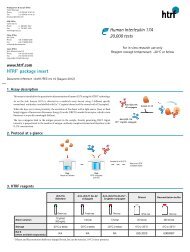

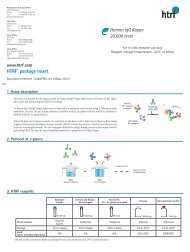
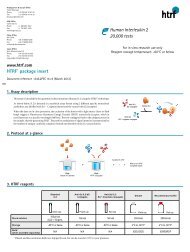
![HTRF meeting_130426_villa_pour pdf [Mode de compatibilité]](https://img.yumpu.com/22345646/1/190x135/htrf-meeting-130426-villa-pour-pdf-mode-de-compatibilitac.jpg?quality=85)